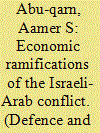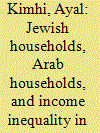|
|
|
Sort Order |
|
|
|
Items / Page
|
|
|
|
|
|
|
| Srl | Item |
| 1 |
ID:
098343


|
|
|
|
|
| Publication |
2010.
|
| Summary/Abstract |
This paper addresses the issue of the impact that armed conflicts have on capital markets. It focuses on the recent Israeli military offensive in the Gaza Strip launched in late 2008 and concluded in early 2009. The paper examines the effects of this armed conflict on the return and volatility of the general index of the Tel Aviv Stock Exchange (TASE), as well as on the government bond index. Furthermore, event study methodology is applied to identify markets' reactions to the Israeli military operations in the Gaza Strip.
|
|
|
|
|
|
|
|
|
|
|
|
|
|
|
|
| 2 |
ID:
098335


|
|
|
|
|
| Publication |
2010.
|
| Summary/Abstract |
This paper revisits the defence-growth nexus for the rivals of the Israeli-Arab conflict over the last four decades. To this end, we utilize the Toda and Yamamoto (1995) causality test and the generalized variance decomposition. Contrary to the conventional wisdom and many earlier studies, we fail to detect any persistent adverse impact of military expenditures on economic growth. Our conclusions are kept intact even when we account for the possibility of endogenous structural breaks and during the post-1979 peace treaty period. Our findings imply insignificant peace dividends once the conflict is resolved and the military spending is cut to internationally acceptable standards.
|
|
|
|
|
|
|
|
|
|
|
|
|
|
|
|
| 3 |
ID:
098333


|
|
|
|
|
| Publication |
2010.
|
| Summary/Abstract |
More than six decades have elapsed since the establishment of the state of Israel, and the Palestinian Nakba (catastrophe) in 1948, which marked the initiation of a long-lasting conflict that has still not yet been resolved. Israelis and Arabs that claim historical solitary rights on the Holy Land have incurred loads of casualties and endured decades of wars, destruction, agony, and a lack of peaceful and prosperous life. The intensity of the conflict is reflected, among other things, by the substantial fraction of the scarce resources that has been allocated to military spending by the adversaries. Throughout the duration of the conflict, Israel and its major rivals, namely Egypt, Jordan and Syria, recorded an internationally unparalleled military burden. Although these countries have cut their defense spending drastically following the initiation of the peace talks, they still maintain exceptionally high military spending in international standards.
|
|
|
|
|
|
|
|
|
|
|
|
|
|
|
|
| 4 |
ID:
098347


|
|
|
|
|
| Publication |
2010.
|
| Summary/Abstract |
This paper quantifies the roles of ethnicity, gender and location in rural income inequality in Israel. Between 10 and 16% of rural income inequality is explained by the Jewish-Arab divide. Schooling and household size, which are respectively much lower and higher among the rural Arab population, also explain significant fractions of income inequality. Location and gender of the household head explain much smaller fractions. Education-enhancing policies directed at the lower end of the schooling distribution, and at Arab municipalities in particular, are recommended to reduce per capita income inequality in rural Israel and narrow the Jewish-Arab gap. This could contribute to reducing the tension between the Jewish majority and the Arab minority in Israel, and to creating a better atmosphere for their neighborly coexistence.
|
|
|
|
|
|
|
|
|
|
|
|
|
|
|
|
| 5 |
ID:
098344


|
|
|
|
|
| Publication |
2010.
|
| Summary/Abstract |
Using a panel of cross sections, this study measures wage differentials between Israeli-Arab and Jewish workers between 1991 and 2003. The wage gap is then decomposed into components corresponding to human capital, occupational segregation, selectivity, and a residual (unexplained gap). The study shows large fluctuations in the wage gap, almost doubling in the last decade, reaching 75% in 1999. Because sudden changes in the underlying characteristics of the populations are not likely, a large part of the level and changes in the wage gap were captured by the residual - possibly one of the implications of the ongoing Israeli-Palestinian conflict.
|
|
|
|
|
|
|
|
|
|
|
|
|
|
|
|
| 6 |
ID:
098339


|
|
|
|
|
| Publication |
2010.
|
| Summary/Abstract |
This paper estimates a structural vector autoregression to assess the empirical effects of terrorism on output and prices in Israel. Long-run restrictions are used to interpret the effects in terms of aggregate demand and supply curves. The responses indicate that the immediate effects of terrorism are similar to those associated with a negative demand shock. Such a leftward shift of the aggregate demand curve is consistent with the existence of adverse effects on most components of aggregate expenditure documented in previous empirical studies. The long-term consequences of terrorism are similar to those related to a negative supply shock. Such a leftward shift of the long-run aggregate supply curve agrees with adverse effects on the determinants of the potential output, such as contractions of physical capital highlighted in earlier work, as well as reductions of technological innovations and slowdowns of net immigrations, which have not been fully analyzed in the existing empirical literature.
|
|
|
|
|
|
|
|
|
|
|
|
|
|
|
|
| 7 |
ID:
098341


|
|
|
|
|
| Publication |
2010.
|
| Summary/Abstract |
This paper investigates the labor market responses to conflict and labor market disruptions in the West Bank and Gaza Strip. From 1987 to 1995 the West Bank and Gaza Strip witnessed an increase in instability as political conflict disrupted the economy. This paper finds that disruptions later in the period are associated with increased reallocation between sectors and lower unemployment, compared to equivalent shocks earlier in the period. Additionally, the effects of these shocks are primarily felt by younger workers. The findings are consistent with a decrease in human capital investment during this time, but several alternative explanations are also explored.
|
|
|
|
|
|
|
|
|
|
|
|
|
|
|
|
| 8 |
ID:
098337


|
|
|
|
|
| Publication |
2010.
|
| Summary/Abstract |
In this paper we explore the patterns of interactions between military expenditure shares in the MENA region over the period 1979-2007. We explore whether there are latent common factors that impact on the military expenditures of 15 countries in the MENA region and whether these factors can be interpreted. Unobserved common factors induce cross-sectional dependence and may lead to traditional panel-time series estimators being inconsistent. To identify these latent factors we apply principal component analysis. We evaluate the interpretation of the estimated factors using the multiple-indicator multiple-cause model. We find that there is a substantial evidence of cross-sectional dependence in the MENA region, induced mainly by two unobserved factors, but these factors are difficult to interpret.
|
|
|
|
|
|
|
|
|
|
|
|
|
|
|
|
|
|
|
|
|